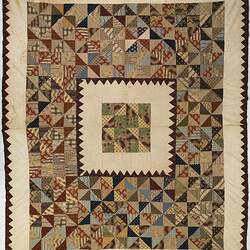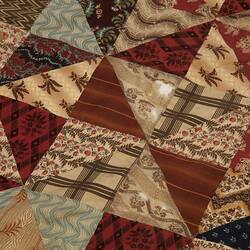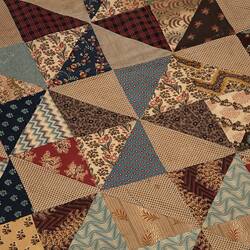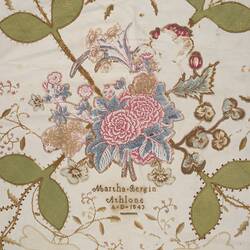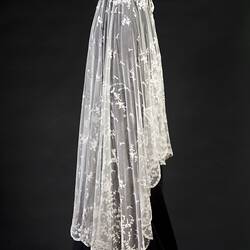Summary
Patchwork quilt brought to Australia by Isabella Falconer Murray Spence (born 1831) when she migrated from Forfar, Scotland with her husband David Spence in 1853. Isabella was the daughter of Margaret Murray (nee Falconer) and the granddaughter of Jane Burn. In 1852 she married David Spence, a tinsmith by trade (born in Dundee, 21 December 1831) in Dundee in Scotland. Isabella and David sailed for Australia from Liverpool on board the 'Ida' on 25 March 1853, arriving in Williamstown on 12 July 1853. David was employed by Langlands, the first iron foundry and shipbuilder in Flinders Lane, Melbourne, and the family settled in Richmond.
The quilt was given to Isabella probably by her grandmother Jane Burn. Family lore has always maintained that it was made by Jane (Lily Spence, the couple's seventh child, always described the quilt when proudly showing it to visitors as having been created by 'her mother's mother's mother'.) The Victorian and Albert Museum's advice on dating the fabrics suggests that the quilt was made in the 1840s or 1850s - which would mean that it is most likely that Jane made the quilt, perhaps as a glory box or wedding gift, directly for her granddaughter.
The patchwork fabrics, made from 'painted cottons' date mainly from the 1820s (the zig-zag stripes) and 1830s and at least one chintz in the central panel may date back to around 1812 (although the style continued in production for a decade or more). The style of patchwork is typical of that of the 1840s or 1850s and it was quite common to use older cottons. The sheen on some of the pieces of fabric is the original glaze which helped to protect the cotton from dirt. Consequently this quilt would have been fairly new in 1853 when it was transported to Australia.
The quilt is one-sided. On the back, raw seams and tacked edges suggest it was never finished, but nevertheless it could have been used, showing one side only.
The quilt was passed down the female line from Jane Burn to Isabella Murray Spence (died 1904) to her daughter to Lily Ann Affleck Spence Mackenzie (born 1866; died 1940) to her daughter Isabella Mackenzie White (born 1893; died 1970) to her daughter Grace White Mathias to her daughter, the donor, Beverley Mathias (who had no children of her own). During this time, the quilt has moved from residence to residence, from its origins in Forfar Scotland to Richmond, Castlemaine, Brighton, Balwyn, Yarraville, back to Scotland with the donor and finally to Melbourne again.
Physical Description
Large cotton quilt consisting of numerous patterned cloth triangles sewn together to create a patchwork of four-inch squares, or units. The units can either be viewed as plain four segment triangle configurations or as pinwheels. The fabrics are in a range of colours and patterns including florals, stripes and zig zags in predominantly browns, reds, creams, blues and green. The quilt has a cream cloth border with saw-tooth edging. This border and edging is repeated at the centre of the quilt framing a patchwork centre medallion. The quilt is not backed, so raw seams are visible. It is also simply tacked around the back edge, suggesting it is unfinished.
Significance
This quilt is demonstrates the importance of objects in providing connections across generations in one family. The role of women in the passing down of valued cultural heirlooms is often central to this process. This quilt has travelled across time, generation and place, through the custodial hands of at least six women across six generations, and eight localities (including inner and suburban Melbourne, regional Victoria and Scotland). The quilt tells stories of migration and is a fine example of the popular craft of quilt making and thus artistic skills.
More Information
-
Collecting Areas
Migration & Cultural Diversity, Clothing & Textiles, Home & Community
-
Acquisition Information
Donation from Miss Beverley Mathias, 02 Jun 2011
-
Place & Date Made
Scotland, Great Britain, 1840s-1850s
Probably made by Isabella's grandmother Jane Burn -
Original Owner
Mrs Isabella Falconer Murray Spence, Victoria, Australia, 1852-1904
-
Maker (Possible)
-
Medium
Cotton
-
Technique
Patchwork
-
Classification
-
Category
-
Discipline
-
Type of item
-
Overall Dimensions
2030 mm (Width), 2500 mm (Height)
-
Overall Dimensions
203 cm (Width), 250 cm (Height)
-
References
Object assessment undertaken by the Victorian & Albert Museum, London, 4 July 1984.
-
Keywords
Bedding, Brought Goods, Crafts, Fabrics, Furnishings, Needlework, Scottish Immigration, Scottish Textiles, Sewing

